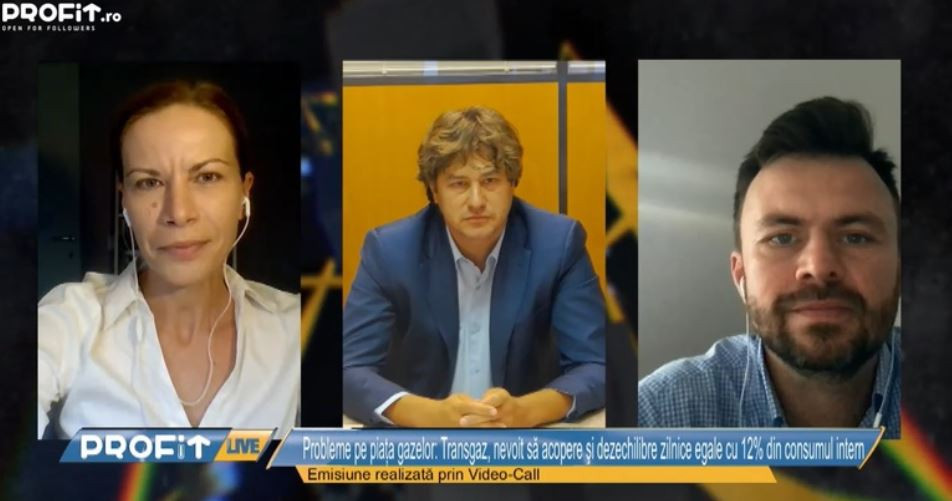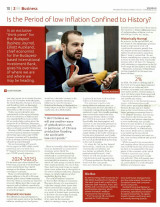Stefan Nanu, IIB Head of the Debt Capital Markets and FI, shared his vision on the Bank's funding and lending strategy with the leading Romanian business channel PROFIT.RO
Source: Profit.ro
Oana Osman, Editor-in-Chief (О.О.): We just commented in the news about the pressures on funding costs. Your bank is an issuer in RON and recently you’ve just issued a RON bond in a new format under MTN (Medium Term Notes) Programme and you listed the bonds in Dublin. Could you tell us how you obtained a reduction in the funding costs and why have you picked up a new format?
Stefan Nanu (S.N.): It’s worth to mention that this was Bank’s 7th RON issuance, therefore, the conditions obtained in our last one are the fruitful result of a continuity in issuing inside Romania (RON and EUR) and in RON outside Romania under MTN. It’s true that during 2015-2019 we issued in a domestic format although in a quasi Reg S format (closed to the international one). This was a very good period of building up a strong relationship with the institutional investor base in Romania. On the other hand taking into account the achievement of the "A" rating from all important rating agencies (the last one - Fitch - occurring during the pandemic context), we had to consider a format that makes the access to our bonds easy to the global investors as well and this is the MTN framework similar with the one used by the Romanian Ministry of Finance. Therefore, we have registered the first IIB’s MTN Programme in March this year in Dublin. Unfortunately, we couldn’t gain that momentum to issue under the fresh MTN because of the pandemic context but we used in that very specific context one of the local currency bond market where we are a frequent issuer, namely the Russian ruble bond market. Once markets started to recover we have issued our first two deals under MTN in RON (April) and CZK (May).
In the fall, the strategy was to take advantage of our redemptions and rolling them over, including here those maturing in Romania (RON 300m and EUR 60m), taking into account that we knew some of the large bondholders wanted to at least keep their exposures on IIB. Therefore, we have issued RON 340m for 3-yr at the historically lowest long-term funding cost for the Bank on the euro-after swap basis. Generally speaking, our strategy is to tap the local currency bond markets of the Member States and to swap the proceeds into EUR taking into account that the Bank balance sheet is in EUR. In this way, we actually could obtain more cost effective terms then if we would issue directly into EUR (sometimes the difference could be even up to 50-60bps).
O.O: Could you please tell us more exactly what were the costs you obtained in your recent RON bond issue?

S.N.: The yield in RON was 3.39% and the euro-after swap fixed rate obtained for the 3-yr maturity is 0,395% (39.5bps). By comparison, two weeks before this issue we have issued a 3-year HUF private placement under MTN obtaining an euro-after swap cost of 80 bps, so we basically halved the borrowing cost for the same maturity. Also, about 3 weeks before the issue we did a RUB issuance obtaining an euro-after swap cost of 1.13% for 2.5 years. So, our strategy is basically to monitor the available funding markets and see what would be the most cost efficient ones for the Bank. It’s also true that the Bank’s funding needs are rather small (in average around EUR 250-300 m), this year being a record year in terms of long-term funding volume - about EUR 480m - due to the special prudential liquidity measures adopted in the pandemic context: ensuring a 12m survival liquidity (prefunding commitments for 12m), a minimum cash in NOSTRO accounts (EUR 70m), an extra buffer of high-rated and high liquid securities of EUR 100m and a cap for short-term debt (up to 3m) up to EUR 100m. Practically the yearly balance sheet growth can not be too large since for the Bank it’s very important to consolidate the ratings and from this perspective a strong capital adequacy has to be secured. The Bank has an internal floor of 25% or capital adequacy but in practice, this is maintained above 30% (for end of H1 is even higher than 34%). What is important to note is that our frequent issuer policy in RON created in time a bond with the local investor base that gradually reflected in better and better spreads vs the G-curve. Therefore, we have reached a spread of 30bps vs the G-curve at our last RON bond issue (down from 45bps last year) which is much tighter than the Bank spread vs G-curve in other local markets (In Hungary is around 100bps and in Russia is around 135bps). The Romanian investors and asset managers lack instruments to diversify their portfolios, and particularly high-rated fixed income local currency assets. Therefore, instruments such as IIB’s bonds that are also paying a premium v the sovereign curve although the Bank rating is 3 notches higher than the Romanian sovereign rating are very much demanded help them to improve the risk while benefiting good returns. Moreover, those Romanian investors who invested in IIB starting with 2015, they witnessed a very strong credit story, with improvements in ratings of 3 notches and a multiplication of the balance sheet by more than 5 times corroborated with more than doubling the paid-in capital in the last 8 years.
Profit.ro (Claudiu): From what you have presented, it seems there is somehow a confidence of investors in Romania. What are the basis and arguments, how much is related to the economic perspective and how much is related to the expectations (such as the ones reflected in a recent S&P report on Romania providing low chances for the measure of hiking pensions by 40% to be implemented)?
S.N.: I will express my personal opinion and I’ll try not to be subjective although as you could imagine I’m close to what Ministry of Finance does and to my former colleagues since I work for many years there. I think the developments in Romania and the investors’ attitude to Romania will be further supported by the context. I believe the easing and quantitative policies adopted by the Central Banks including NBR will stay for some time and could be even intensified, since the uncertainties caused by the pandemic context are still persisting. On the other hand, Romanian sovereign curve has an extra premium already priced in in my opinion, both the Eurobond curve and the RON curve. If we make a comparative analysis, it’s easy to see that the spread of around 150bps between Romania and Bulgaria or Hungary (which are Romania’s peers) is not justified from the economic fundamentals viewpoint. So, if Romanian authorities will adopt the logical expected policies and measures in the next period this spread will adjust/correct. Also, I share minister of finance Florin Citu’s opinion that there is still room for more accommodative measures that could reduce the domestic interest rates in Romania and therefore, consequently, supporting low funding costs. One should observe that Romania is probably one of the very fewest if not the only one country in the region offering real positive interest rates to the institutional investors and asset managers. For ex, in neighboring countries such as Hungary, the whole sovereign curve is below 2.5% when the CPI is around 3.5% or slightly above. This means the asset managers in Hungary have to diversify to riskier assets to cover the inflation for ex. So, there are policy buffers from the viewpoint of instruments and policies available to the authorities although the fiscal pressures are high and therefore, I hope that the fiscal policies to be adopted further in Romania would be coherent and correct ones. From the discussions I had recently with the foreign and domestic investors they looked to me also optimistic from this perspective.
O.O.: You have told us so far about the funding part, could you let us know how is the Bank choosing its investments, particularly in Romania, we note that the portfolio is pretty diversified from agribusiness to medical equipment, support to financial institutions, etc. What are the Bank’s strengths and advantages comparing with other IFIs and commercial banks?
S.N.: Yes, you are right, also from the Bank lending and investment perspective, Romania is one of the champions/main beneficiaries if we consolidate the lending and project finance with the treasury investments. Our regular presence on the funding and lending side in Romania created some traditional partners and clients and two of them are from the financial sector. You mentioned Agricover which is supported via lending to develop the agribusiness in Romania while with Banca Transilvania Group we have a wide spectrum of business from funding side to our support investments in the bonds issued by Banca Transilvania (tier II capital) and BT Leasing. Our investment in those bonds was favored also by the fact that the bonds are euro-denominated and it is easier for us to invest in such securities but we could also lend and invest in local currency bonds. For example, in Hungary we started to participate in a local currency corporate bond program supported also by the Hungarian Central Bank. Continuing with the portfolio in Romania, it’s true it is very diversified, we supported also acquisitions (the take over of Urgent Cargus by MEP or the cross border acquisition of oil factory from Tandarei by an investor from Republic of Moldova), investments in medical sector (Medicover), commercial real estate sector such as Iulius Mall or agribusiness (Avicola or milk factory in Brasov).
IIB is rather a boutique IFI and can not be compared with larger IFIs that could make available very large volumes of funding and operations but we are more straightforward and quicker in the decision-making process and in terms of project approval and also more flexible which makes us popular among many clients and also among other players from financial markets (syndications) who are calling us to participate in various deals. Personally I know also the processes in the World Bank since I worked there and in their case the approval process for a project could last even longer than one-year while in our case it takes few months or even faster if need be. Also, when it comes with our cooperation with local commercial banks, we do not crowd them out and do not compete with them on fees and cross-selling since we do not have operations for clients but we just share risks and exposures with the commercial banks.
Lately, in Covid crisis context, our Bank has supported actively the primary markets of Eurobonds issued by the Member States since we considered important to support them in funding elevated budgetary deficits (Bulgaria, Slovakia, Romania, Hungary) but from a development mandate perspective one specific focus/target is on supporting the primary markets of green bonds issued both by sovereigns and corporates. We invested for example in the first green bond issued by Hungary but also we are looking outside the Member States from this perspective.
Coming back to the Bank investments in Romania it is worthy to mention that the Bank invested about 10 times more than the country’s participation in the Bank’s equity, which shows a very high multiplier effect. Another important advantage to be mentioned is that the Bank offers to the entrepreneurs from Bank’s European Member States but not only, instruments to allow them to finance the trade and cross-border investments in countries that could be considered with political risk. In this way, the Bank covers a gap which is not covered by the local banks or commercial banks generally speaking. IIB has many trade finance operations developed in the recent years in countries such as Russia, Belarus, Vietnam, Mongolia and other third countries where Bank has a good knowledge about the embedded risks and assumes such risks. From this perspective we are looking to strengthen our partnership with the Romanian Eximbank, to support them in expanding their activities and support development of such instruments.


